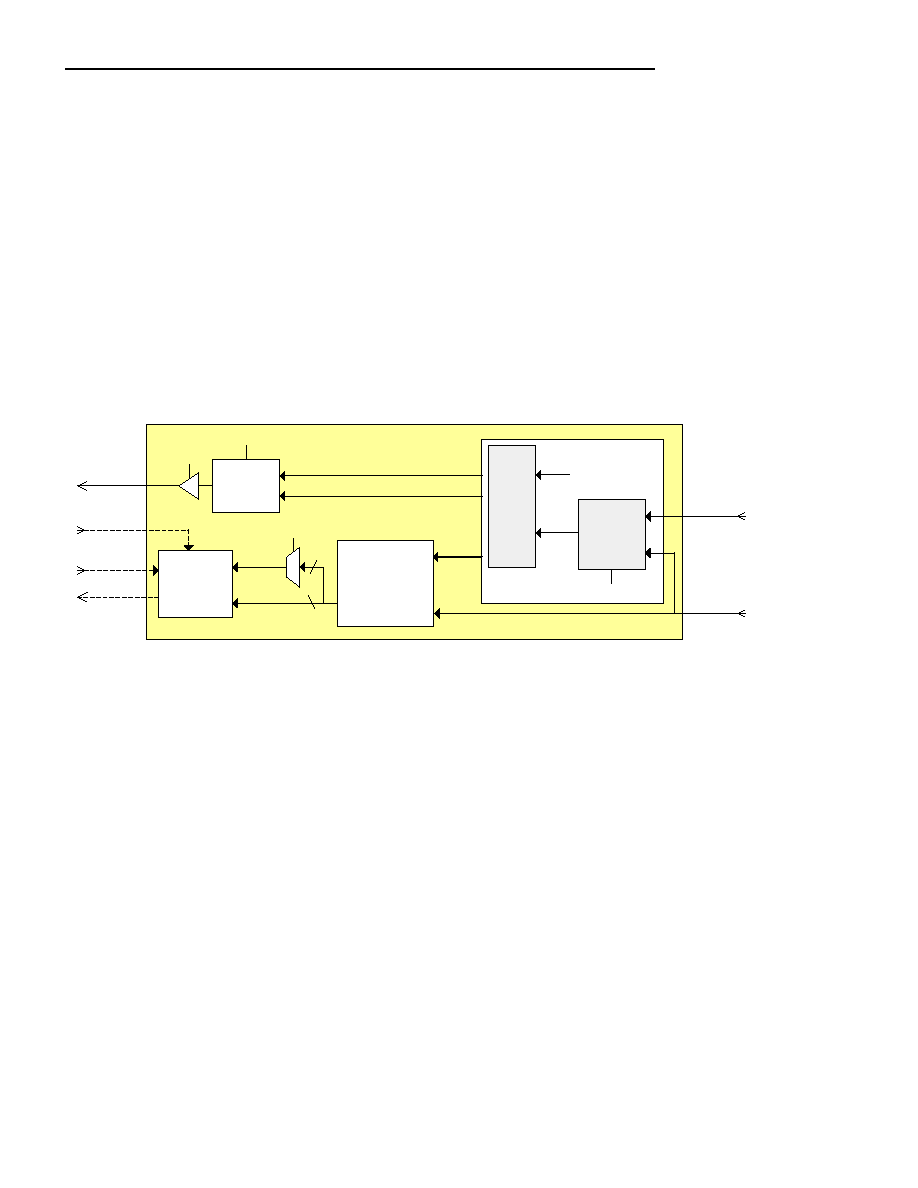- 您現(xiàn)在的位置:買賣IC網(wǎng) > PDF目錄1916 > DS34S132GN+ (Maxim Integrated Products)IC TDM OVER PACKET 676-BGA PDF資料下載
參數(shù)資料
| 型號(hào): | DS34S132GN+ |
| 廠商: | Maxim Integrated Products |
| 文件頁數(shù): | 121/194頁 |
| 文件大?。?/td> | 0K |
| 描述: | IC TDM OVER PACKET 676-BGA |
| 產(chǎn)品培訓(xùn)模塊: | Lead (SnPb) Finish for COTS Obsolescence Mitigation Program |
| 標(biāo)準(zhǔn)包裝: | 40 |
| 功能: | TDM-over-Packet(TDMoP) |
| 接口: | TDMoP |
| 電路數(shù): | 1 |
| 電源電壓: | 1.8V, 3.3V |
| 工作溫度: | -40°C ~ 85°C |
| 安裝類型: | 表面貼裝 |
| 封裝/外殼: | 676-BGA |
| 供應(yīng)商設(shè)備封裝: | 676-PBGA(27x27) |
| 包裝: | 管件 |
| 其它名稱: | 90-34S13+2N0 |
第1頁第2頁第3頁第4頁第5頁第6頁第7頁第8頁第9頁第10頁第11頁第12頁第13頁第14頁第15頁第16頁第17頁第18頁第19頁第20頁第21頁第22頁第23頁第24頁第25頁第26頁第27頁第28頁第29頁第30頁第31頁第32頁第33頁第34頁第35頁第36頁第37頁第38頁第39頁第40頁第41頁第42頁第43頁第44頁第45頁第46頁第47頁第48頁第49頁第50頁第51頁第52頁第53頁第54頁第55頁第56頁第57頁第58頁第59頁第60頁第61頁第62頁第63頁第64頁第65頁第66頁第67頁第68頁第69頁第70頁第71頁第72頁第73頁第74頁第75頁第76頁第77頁第78頁第79頁第80頁第81頁第82頁第83頁第84頁第85頁第86頁第87頁第88頁第89頁第90頁第91頁第92頁第93頁第94頁第95頁第96頁第97頁第98頁第99頁第100頁第101頁第102頁第103頁第104頁第105頁第106頁第107頁第108頁第109頁第110頁第111頁第112頁第113頁第114頁第115頁第116頁第117頁第118頁第119頁第120頁當(dāng)前第121頁第122頁第123頁第124頁第125頁第126頁第127頁第128頁第129頁第130頁第131頁第132頁第133頁第134頁第135頁第136頁第137頁第138頁第139頁第140頁第141頁第142頁第143頁第144頁第145頁第146頁第147頁第148頁第149頁第150頁第151頁第152頁第153頁第154頁第155頁第156頁第157頁第158頁第159頁第160頁第161頁第162頁第163頁第164頁第165頁第166頁第167頁第168頁第169頁第170頁第171頁第172頁第173頁第174頁第175頁第176頁第177頁第178頁第179頁第180頁第181頁第182頁第183頁第184頁第185頁第186頁第187頁第188頁第189頁第190頁第191頁第192頁第193頁第194頁

DS34S132 DATA SHEET
19-4750; Rev 1; 07/11
32 of 194
9.2 TDM Port Functions
The S132 includes 32 TDM Ports. Each TDM Port can be used to support a T1, E1 or any slower TDM data
stream. Each TDM Port uses a serial clock and data interface. The high level functions include:
Structured & Unstructured Formats
T1, E1 and slower TDM Port Line Rates
T1SF, T1ESF and E1 Multi-frame Formats
N x 64 Kb/s PW Packet Payload Rates
With & without CAS Signaling
DS0 Timeslot Assignment
CPU Monitor and Control of CAS Signaling
CPU Control for Data Conditioning
TDM Port Timing
From Recovered or External Time References
Adaptive & Differential Clock Recovery
Generates Differential & Absolute Timestamps
TDM Port, Timeslot and PW Loopbacks
BERT Diagnostics
9.2.1 TDM Port Related Input and Output Clocks
The TDM Port Input and Output Clocks are identified in Figure 9-7.
Figure 9-7. TDM Port Input and Output Clock Overview
DS34S132
CLAD
Ck
Select
Freq
Synthesizer
CLAD
Clock
Select
1.544 MHz
synclk
REFCLK
LIUCLK
2.048 MHz
LCS
LCE
SCS
32 Clock
Recovery
Engines
TDM
Port n
(n = 1 - 32)
EXTCLK0
EXTCLK1
RCLKn
TCLKOn
aclk_n
grclk
32
GRCSS
32
Freq Select
FS[3:0]
CMNCLK
DCR
Common
Clock
High Quality
Reference
(e.g. OCXO)
synclk
_ref_in
The S132 Clock Recovery Engines support “Adaptive Clock Recovery” (ACR) and “Differential Clock Recovery”
(DCR). The ACR technique measures the timing of each successive RXP Packet to determine the recovered clock
frequency. The DCR technique uses RTP timestamps to determine the recovered clock frequency. Two external
clock recovery reference inputs (REFCLK and CMNCLK) are used to supply 1) a Frequency Synthesizer reference
input and 2) to provide a DCR common clock reference.
The Frequency Synthesizer reference input (synclk_ref_in) is required to generate an internal “synclk” signal. To
achieve the jitter/wander performance of ITU G.823/824/8261 the reference should be at least equal to that of a
Stratum 3 clock. The reference can be input on either REFCLK or CMNCLK (selected with G.CCR.SCS). For PSTN
and Cellular Mobile Phone applications, the BITS or GPS Network Timing commonly provide at least a Stratum 3
reference. For applications where a Network Timing reference is not available, then an OCXO may be used. Some
specialized TCXOs can also meet these stringent requirements. Otherwise, if the jitter/wander requirements can be
relaxed then the synclk reference input signal requirements can be equally relaxed.
To support the DCR mode, both ends of the PW must share a common clock reference that is derived from a single
timing source so that the frequency of the common clock reference at both ends of the PW are locked to each
other. The CMNCLK input is used to provide the DCR common clock reference.
In public network applications that use the DCR mode, the public network broadcast Network Timing, that provides
a Stratum 3 or better reference (e.g. BITS or GPS), can be used for the DCR common clock (CMNCLK) input and
the synclk reference input; and the REFCLK input can be tied low to save power.
In applications that use the DCR mode, but the DCR common clock reference is not a Stratum 3 reference (e.g.
private networks), the DCR common clock is connected to the CMNCLK input and a high quality reference (e.g.
OCXO) is connected to the REFCLK input.
In applications that do not use the DCR mode, only a high quality reference is required that can be connected to
CMNCLK or REFCLK and the unused input pin can be tied low to save power.
相關(guān)PDF資料 |
PDF描述 |
|---|---|
| DS34T102GN+ | IC TDM OVER PACKET 484TEBGA |
| DS3501U+H | IC POT NV 128POS HV 10-USOP |
| DS3502U+ | IC POT DGTL NV 128TAP 10-MSOP |
| DS3503U+ | IC POT DGTL NV 128TAP 10-MSOP |
| DS3897MX | IC TXRX BTL TRAPEZIODAL 20-SOIC |
相關(guān)代理商/技術(shù)參數(shù) |
參數(shù)描述 |
|---|---|
| DS34S132GN+ | 功能描述:通信集成電路 - 若干 32Port TDM-Over-Pack Transport Device RoHS:否 制造商:Maxim Integrated 類型:Transport Devices 封裝 / 箱體:TECSBGA-256 數(shù)據(jù)速率:100 Mbps 電源電壓-最大:1.89 V, 3.465 V 電源電壓-最小:1.71 V, 3.135 V 電源電流:50 mA, 225 mA 最大工作溫度:+ 85 C 最小工作溫度:- 40 C 封裝:Tube |
| DS34S132GNA2+ | 功能描述:通信集成電路 - 若干 32Port TDM-Over-Pack Transport Device RoHS:否 制造商:Maxim Integrated 類型:Transport Devices 封裝 / 箱體:TECSBGA-256 數(shù)據(jù)速率:100 Mbps 電源電壓-最大:1.89 V, 3.465 V 電源電壓-最小:1.71 V, 3.135 V 電源電流:50 mA, 225 mA 最大工作溫度:+ 85 C 最小工作溫度:- 40 C 封裝:Tube |
| DS34T101 | 制造商:MAXIM 制造商全稱:Maxim Integrated Products 功能描述:Single/Dual/Quad/Octal TDM-over-Packet Chip |
| DS34T101_08 | 制造商:MAXIM 制造商全稱:Maxim Integrated Products 功能描述:Single/Dual/Quad/Octal TDM-over-Packet Chip |
| DS34T101_09 | 制造商:MAXIM 制造商全稱:Maxim Integrated Products 功能描述:Single/Dual/Quad/Octal TDM-over-Packet Chip |
發(fā)布緊急采購,3分鐘左右您將得到回復(fù)。